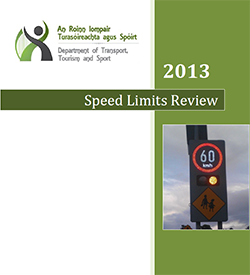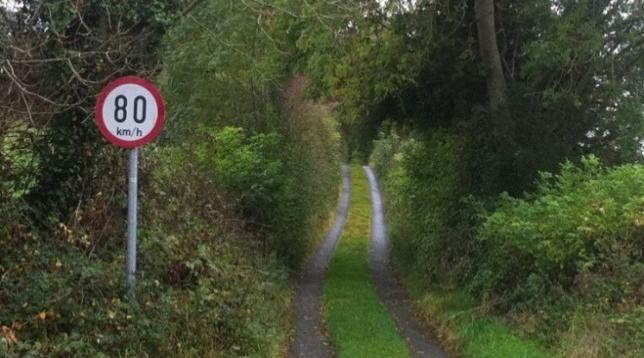 MAG Ireland has reported that new proposals published by a Speed Limits Working Group are to address the inconsistencies in Ireland’s speed limits.
MAG Ireland has reported that new proposals published by a Speed Limits Working Group are to address the inconsistencies in Ireland’s speed limits.
MAG Ireland welcomes the recommendations “as a positive step in ensuring a balanced and transparent approach to the setting of limits appropriate to the road in question. In particular, we welcome the announcement that the limits are to be reviewed every five years.”
In addition they add, “We welcome the announcement that special speed limits, which are currently the remit of a city or county council, will be subject to review and engineering oversight. Such limits are intended for use in specific locations, such as pedestrian-centric areas, shopping precincts and school entrances. However, they have been used inappropriately, for example the blanket 30kph limits imposed on large urban areas and key arterial routes in Dublin.”
Finally MAG Ireland concludes that, “Blatantly inappropriate speed limits do nothing but damage public support for road safety in general, and MAG Ireland welcomes the announcement that this issue is finally being addressed.”
At Right To Ride here in Northern Ireland we have commented on a 20mph campaign as well as on a Private Members Bill introduced in the Northern Ireland Assembly for a blanket 20mph limits where people live and on the Roads Service 20 mph pilot schemes for example outside schools. – Saying Plenty About 20
Silly Signs
 A couple of things we picked up from MAG Ireland and the speed review report included– “Silly signs’ which may encourage inappropriate speeds will be removed”. For example, “An 80 km/h sign as the road is entering a bend where it is clear the road cannot be driven at this speed and the road user should be slowing down.” – “Boreen (road) with grass growing up the middle (imagine a farmers track leading to a field) that has a posted Speed Limit of 80km/h even though it is not possible to drive at that speed.”
A couple of things we picked up from MAG Ireland and the speed review report included– “Silly signs’ which may encourage inappropriate speeds will be removed”. For example, “An 80 km/h sign as the road is entering a bend where it is clear the road cannot be driven at this speed and the road user should be slowing down.” – “Boreen (road) with grass growing up the middle (imagine a farmers track leading to a field) that has a posted Speed Limit of 80km/h even though it is not possible to drive at that speed.”
From what we understand this signage “problem” regarding speed limits seems to have stemmed from 2004 when provisions were made in a Road Traffic Act 2004 (amended in 2010) for the establishment of a range of Default and Special Speed Limits.
This did away with the previous speed limit signs in mph and introduced a metric value for Speed Limits – kph – previously roads signs carried speed limit in mph and distances in kilometres.
However this also got rid of what we know in the UK and Northern Ireland as the “derestricted” sign, a circular sign with a white background, bearing back a diagonal band. Which means the national speed limit applies for that road or rather – “The speed limit is the absolute maximum and it doesn’t mean it’s safe to drive at this speed in all conditions.”
These signs are not made up without a reason and from our previous attendance as a representative of other organisations (pre Right To Ride) at the UN in Geneva, we are well aware through the UNECE WP1 – Working Party on Road Traffic Safety – Convention on Road Signs and Signals (Vienna, 8 November 1968) – Ireland is not party to the convention but this does not stop them from adopting the road signs and markings.
Silly Petition?
All this may seem complicated however as this all gets sorted out by “experts”, the European citizen can bring a touch of mental instability to the proceedings.
Earlier this year a European Citizen (German) submitted to the European Parliament’s, Committee on Petitions, a petition which called, “For the introduction of traffic signs that all Europeans can understand. He gives as an example the warning ‘RAPPEL’ in France, which cannot be understood without knowledge of French. He therefore calls for a second language to be added to traffic signs displaying text. Given that most Europeans know English, in his view this would be the most obvious choice. He considers that, now that all EU citizens can travel freely through the EU, they ought to be able to understand traffic signs.”
The European Union Commission pointed out that, “EU legislation does not cover the language of road signs, as this issue is regulated by the Convention on Road Signs and Signals done at Vienna on 8 November 1968 under the auspices of the United Nations Economic Commission for Europe.”
Thanks goodness of the Convention and as the Commission pointed out: the Convention, “Provides for the preferential use of graphic symbols rather than inscriptions. Additional explanatory inscriptions can be added to certain signs. Such inscriptions should be in the official language(s) of the Contracting Party, but may be also in foreign languages. For signs indicating directions or information, Article 14(4) of the Convention sets a limit of two languages per sign. While the European Union is not a Contracting Party, the majority of Member States signed the Convention. The Member State Contracting Party to the Vienna Convention has exclusive competence to decide which language to use.”
Maybe not so mad as signs in Wales are bilingual – what other language would we choose – we give thanks to our simple road traffic signs – unless you have a differing opinion – but please save us from the European Citizen wherever they hail from!
As MAG Ireland say, “Blatantly inappropriate speed limits do nothing but damage public support for road safety in general.”
Speed Limits Working Group publishes recommendations
21st November 2013
Average speed limits could be introduced on motorways or other long-distance fixed roads under new proposals published by the Speed Limits Working Group which was set up by Minister Varadkar to address the inconsistencies in Ireland’s speed limits.
The major points of the review, carried out by the department of Transport, Tourism and Sport, include:
- 80kmh signs on narrow country roads will be removed
- New ‘rural speed limit’ signs will be introduced to replace them
- New appeals mechanism for inappropriate speed limits
- Every speed limit will be audited every five years
- ‘Silly signs’ which may encourage inappropriate speeds will be removed
- Road work speed restrictions will be limited to construction period
- Variable speed limits, average speed detection, and in-car satnav speed warnings will be piloted
MAG Ireland welcomes the recommendations as a positive step in ensuring a balanced and transparent approach to the setting of limits appropriate to the road in question. In particular, we welcome the announcement that the limits are to be reviewed every five years.
In addition we welcome the announcement that special speed limits, which are currently the remit of a city or county council, will be subject to review and engineering oversight. Such limits are intended for use in specific locations, such as pedestrian-centric areas, shopping precincts and school entrances. However, they have been used inappropriately, for example the blanket 30kph limits imposed on large urban areas and key arterial routes in Dublin.
Blatantly inappropriate speed limits do nothing but damage public support for road safety in general, and MAG Ireland welcomes the announcement that this issue is finally being addressed.
Original Source – MAG Ireland – Click Here
Information & Links
Speed Limits Review 2013 – Report pdf – 2.5mb – Click Here
Convention on Road Signs and Signals of 1968 European Agreement Supplementing the Convention and Protocol on Road Markings, Additional to the European Agreement – Click Here
Convention on Road Traffic of 1968 and and European Agreement Supplementing the Convention – Click Here
Petition by Udo Loggen (German), on traffic signs that all Europeans can understand – Click Here
Northern Ireland Speed Limits
Built-up areas
Single carriageways
Dual carriageways
Motorways
Type of vehicle mph
(km/h)mph
(km/h)mph
(km/h)mph
(km/h)Cars and motorcycles
(including car-derived vans up to two tonnes maximum laden weight)30
(48)60
(96)70
(112)70
(112)
Goods vehicles
(not exceeding 7.5 tonnes maximum laden weight)30
(48)50
(80)60
(96)70
(112)You can find out more information in the Highway Code 117-126 – Click Here
Table Source – NI Direct Government Services – Click Here


Speak Your Mind